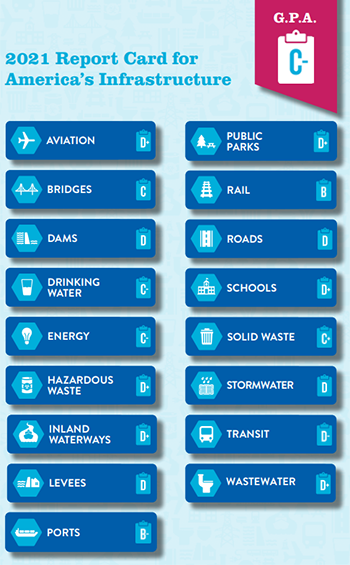The American Society of Civil Engineers (ASCE) unveiled their 2021 Report Card for America’s Infrastructure on Wednesday, March 3. The nation earned a ‘C-’, up from 2017’s cumulative GPA of ‘D+’. This is the first time since ASCE began issuing the report card that the nation’s infrastructure has received a GPA outside of the D range.
The highest grade was the ‘B’ in the rail category, while the lowest was the ‘D-’ for the nation’s transit systems. The report finds that 45% of Americans lack reliable access to transit services. Eleven categories received grades in the ‘D’ range. The Report Card covers 17 categories of infrastructure pertinent to all Americans: , including a new stormwater chapter, and a spotlight on broadband. With the ongoing COVID-19 pandemic, the need for national broadband infrastructure has become more apparent than ever during the last year.
 Between 2017 and 2021, five category grades increased while only one—bridges—decreased. This, combined with state and local governments’ commitment to improving infrastructure, indicate that infrastructure investment in the United State is trending upwards. However, 11 of the 17 categories received scores in the ‘D’ range: aviation, dams, hazardous waste, inland waterways, levees, public parks, roads, schools, stormwater, transit, and wastewater. This demonstrates that much more work is needed to be done to improve the overall infrastructure network.
Between 2017 and 2021, five category grades increased while only one—bridges—decreased. This, combined with state and local governments’ commitment to improving infrastructure, indicate that infrastructure investment in the United State is trending upwards. However, 11 of the 17 categories received scores in the ‘D’ range: aviation, dams, hazardous waste, inland waterways, levees, public parks, roads, schools, stormwater, transit, and wastewater. This demonstrates that much more work is needed to be done to improve the overall infrastructure network.
Many sectors, especially those with lower grades, have staggering maintenance backlogs. Implementation of asset management can be helpful for these categories to ensure maintenance needs are taken care of when necessary. With such large backlogs, developing a clear understanding of where available funds are most needed is essential for protecting lives and maintaining a productive economy.
The country’s total infrastructure needs over the next 10 years total nearly $6 trillion, but after considering various sources of committed funding, the gap to meet those needs is $2.59 trillion. If this is not addressed, America’s overdue infrastructure bill will cost each American household approximately $3,300 per year, or $63 per week.
 Meanwhile in Georgia
Meanwhile in Georgia
The 2019 Georgia Infrastructure Report Card represents the fourth evaluation performed by the Georgia Section of ASCE and focuses on 14 categories of infrastructure. In 2019, the overall grade for Georgia’s infrastructure improved for the first time ever, rising to a cumulative grade of C+ from a C in 2014. The grade for nine of the categories increased, went down for two categories and stayed the same for three categories. Challenges identidied in the 2019 Georgia Infrastructure Report Card include:
- A significant number of our water-related utilities (drinking water, wastewater and stormwater) are consistently underfunded. The long-term viability of these utilities will require adequate user fees that cover the full cost of service.
- Since 2014, Georgia has more than doubled its dam safety staff and significantly improved the number of emergency action plans. As more deficient dams are identified, the state should press for alternative funding options such as grant programs to ensure private dams are repaired in order to protect downstream lives and property.
- The ongoing Savannah Harbor Expansion Project remains a bright spot in Georgia’s efforts to create deep water ports. The long-term viability of these ports will require improved rail and truck freight transportation networks to efficiently get goods to and from the port.
- Landfill owners should consider raising solid waste tipping fees for out-of-state waste. Georgia’s per capita waste generation is skewed to almost double the national average due to our tipping fees being significantly less than bordering states.